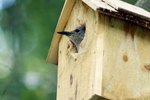
Hamsters only feel secure when they have somewhere to hide, rest and sleep. They aren’t, however, especially picky about what this hideout looks like or what it’s made from. Making your own, whether to save money, because you feel craft-inclined or because you’re in a hurry is perfectly feasible. Just ensure the hideout is actually safe for hamsters.
Cardboard Boxes
Cardboard boxes make excellent hamster nest boxes and it isn’t difficult to find a box of the right size; local stores are full of empty boxes of all shapes and sizes, which they’d probably be only too happy for you to take off their hands.
Note that cardboard cannot be cleaned easily, so you must replace the box every time you clean the cage, which can be a bit disruptive to your pet. A compromise is to have one permanent plastic or wooden hideout and provide cardboard boxes as holiday homes.
To make a cardboard nest box, find a small, plain cardboard box that is smaller than the cage and bigger than the hamster. Avoid any with paint or plastic coatings, which could be toxic. Cut a hamster-sized hole in one size and put it in the cage.
PVC Pipe
PVC pipe is far tougher than cardboard and should last longer. It is also easy to wipe clean. You need a piece about 1 to 2 feet long with a diameter of about 6 inches. Narrower tubes make good tunnels but not sleeping places. Block off one end of the pipe with tightly stuffed cardboard or paper and place it in the cage. This is a bit more open than a nest box and is best provided in addition to, not instead of, a more conventional sleeping hut.
Wood
Wood might be more absorbent than plastic, but a wooden nest box works well provided the base is open, so the bottom consists of bedding rather than wood. Even a mediocre carpenter shouldn’t find a hamster nest box a difficult or time consuming project.
You’ll need five pieces of non-toxic wood, screws or non-toxic wood glue and a saw. Make a five-sided box with the open end opposite the largest side. Cut a hamster-sized archway at one end and place it in the cage. Don’t paint the box -- your hamster will gnaw on it, and paint is often toxic or at least indigestible.
Other Materials
Fictional characters might have their hamsters sleeping in baked bean cans and the like, but metals do not make good materials for a hamster home. The edges are sharp and many such containers rust fast, posing a hazard to both you and the hamster.
Soft plastics, such as milk bottles, are liable to be chewed up as quickly as cardboard, without the advantage of then forming a soft bedding. Thin, brittle plastics, such as soda bottles, develop sharp edges when chewed.
A clay or tough plastic flower pot does make quite a good extra hideout though. Place it upside down if the hole is big enough for the hamster to squeeze through, or on its side if it's not.
References
Photo Credits
-
BananaStock/BananaStock/Getty Images
Writer Bio
Judith Willson has been writing since 2009, specializing in environmental and scientific topics. She has written content for school websites and worked for a Glasgow newspaper. Willson has a Master of Arts in English from the University of Aberdeen, Scotland.



